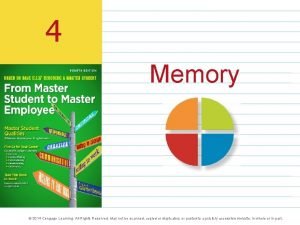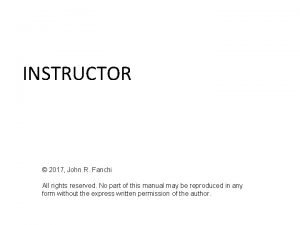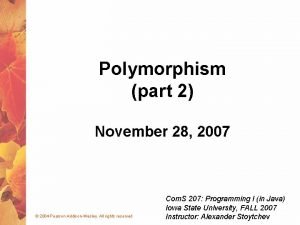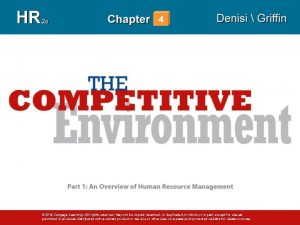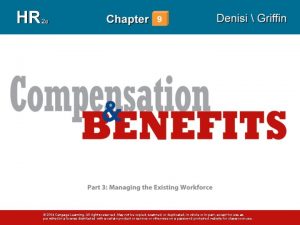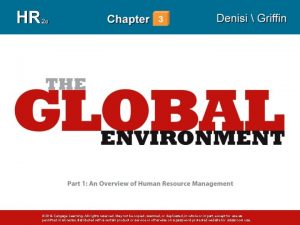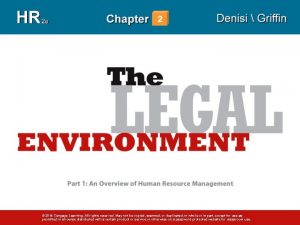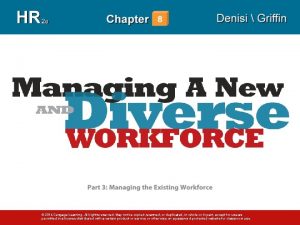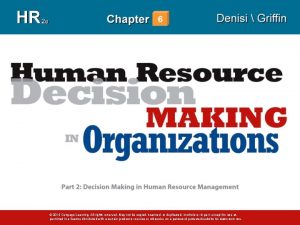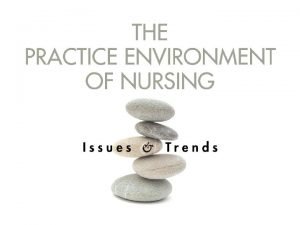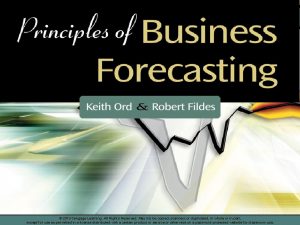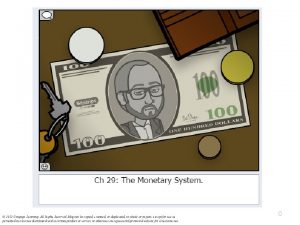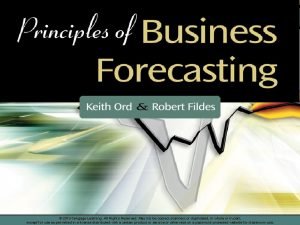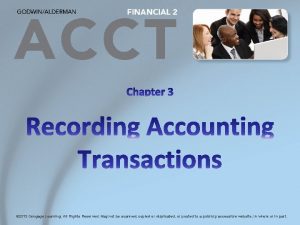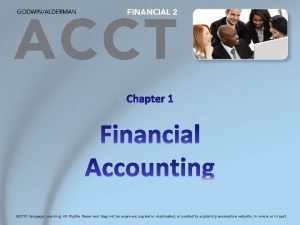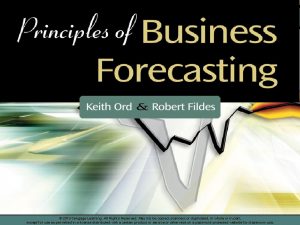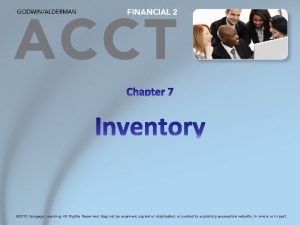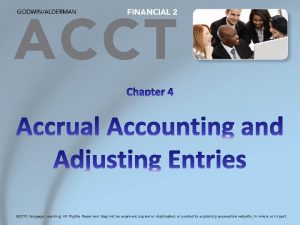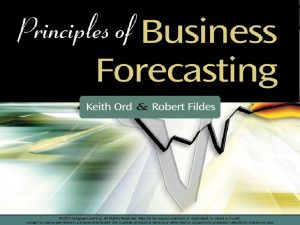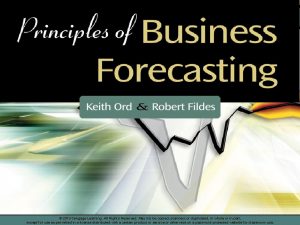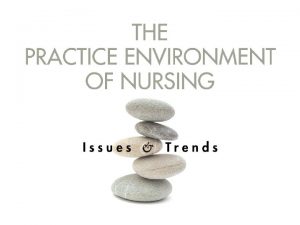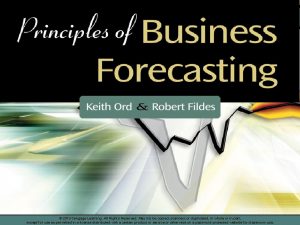2014 Cengage Learning All rights reserved May not
































- Slides: 32

© 2014 Cengage Learning. All rights reserved. May not be copied, scanned, or duplicated, in whole or in part, except for use as permitted in a license distributed with a certain product or service or otherwise on a password-protected website for classroom use.

Learning Objectives After studying this chapter, you should be able to: 1. Describe the legal context of human resource management 2. Identify key laws that prohibit discrimination in the workplace and discuss equal employment opportunity 3. Discuss legal issues in compensation, labor relations, and other areas in human resource management 4. Discuss the importance to an organization of evaluating its legal compliance © 2014 Cengage Learning. All rights reserved. May not be copied, scanned, or duplicated, in whole or in part, except for use as permitted in a license distributed with a certain product or service or otherwise on a password-protected website for classroom use. 2– 2

The Regulatory Environment of HRM • Regulation can come in the form of new laws or statutes passed by national, state, or local government bodies. • Most regulations start at the national level. • State and local regulations are more likely to extend or modify national regulations rather than create new ones. © 2014 Cengage Learning. All rights reserved. May not be copied, scanned, or duplicated, in whole or in part, except for use as permitted in a license distributed with a certain product or service or otherwise on a password-protected website for classroom use. 2– 3

Legal Regulation of Human Resource Management Prospective employees Protection from discrimination in selection, initial job placement, and initial compensation Current employees Protection from discrimination in performance appraisal, subsequent job placements, training and development opportunities, career and promotion opportunities, and all other dimensions of work in the organization © 2014 Cengage Learning. All rights reserved. May not be copied, scanned, or duplicated, in whole or in part, except for use as permitted in a license distributed with a certain product or service or otherwise on a password-protected website for classroom use. 2– 4

Types of Discrimination • Illegal Discrimination Ø Results from behaviors or actions by an organization or managers that cause protected class members to be unfairly differentiated from others • Disparate Treatment Ø When the differential treatment of individuals is based race, color, religion, sex, national origin, age, or disability status. © 2014 Cengage Learning. All rights reserved. May not be copied, scanned, or duplicated, in whole or in part, except for use as permitted in a license distributed with a certain product or service or otherwise on a password-protected website for classroom use. 2– 5

Forms of Illegal Discrimination Disparate impact Disparate treatment Forms of illegal discrimination Retaliation Pattern or practice © 2014 Cengage Learning. All rights reserved. May not be copied, scanned, or duplicated, in whole or in part, except for use as permitted in a license distributed with a certain product or service or otherwise on a password-protected website for classroom use. 2– 6

Title VII of the Civil Rights Act of 1964 • It is illegal for an employer to fail or refuse to hire or to discharge any individual or to discriminate in any other way against any individual with respect to any aspect of the employment relationship on the basis of that individual’s race, color, religious beliefs, sex, or national origin. © 2014 Cengage Learning. All rights reserved. May not be copied, scanned, or duplicated, in whole or in part, except for use as permitted in a license distributed with a certain product or service or otherwise on a password-protected website for classroom use. 2– 7

Bona Fide Occupational Qualification (BFOQ) • BFOQ Ø A condition (e. g. , age, sex, or other personal characteristic) that legitimately affects a person’s ability to perform a job. • Business Necessity Ø Is a practice that is important for the safe and efficient operation of the business, thus is a permissible BFOQ. Ø Indicates an employment practice shown to be related to successful job performance. © 2014 Cengage Learning. All rights reserved. May not be copied, scanned, or duplicated, in whole or in part, except for use as permitted in a license distributed with a certain product or service or otherwise on a password-protected website for classroom use. 2– 8

Diaz v. Pan American World Airways • Cello Diaz was denied employment because Pan Am had a hiring policy of hiring only female flight attendants Ø Courts cited that Pan Am’s data on relative effectiveness of male and female flight attendants was not compelling Ø No evidence existed to prevent males from being employed as flight attendants. © 2014 Cengage Learning. All rights reserved. May not be copied, scanned, or duplicated, in whole or in part, except for use as permitted in a license distributed with a certain product or service or otherwise on a password-protected website for classroom use. 2– 9

Disparate Impact • Occurs when an apparently neutral employment practice disproportionately excludes a protected group from employment opportunities • Griggs v. Duke Power case • Four-fifths Rule Ø Suggests that disparate impact exists if a selection criterion results in a selection rate for a protected class that is less than four-fifths (80 percent) of that for the majority group © 2014 Cengage Learning. All rights reserved. May not be copied, scanned, or duplicated, in whole or in part, except for use as permitted in a license distributed with a certain product or service or otherwise on a password-protected website for classroom use. 2– 10

Disparate Impact (cont’d) • Ward’s Cove Packing v. Antonio case Ø Statistical evidence alone is not sufficient to establish a prima facie case for discrimination. • Geographical Comparisons Ø Compares the characteristics of the potential pool of qualified applicants for a job (focusing on characteristics such as race, ethnicity, and gender) with those same characteristics of the present employees in the job. © 2014 Cengage Learning. All rights reserved. May not be copied, scanned, or duplicated, in whole or in part, except for use as permitted in a license distributed with a certain product or service or otherwise on a password-protected website for classroom use. 2– 11

Disparate Impact (cont’d) • Mc. Donnell-Douglas Test Ø A basis for establishing a prima facie case of disparate impact discrimination Ø Four steps: 1. Applicant is a member of a protected class. 2. Applicant was qualified. 3. Applicant was turned down. 4. Firm continued to seek other applicants with the same qualifications. © 2014 Cengage Learning. All rights reserved. May not be copied, scanned, or duplicated, in whole or in part, except for use as permitted in a license distributed with a certain product or service or otherwise on a password-protected website for classroom use. 2– 12

Disparate Impact (cont’d) • Pattern or Practice Discrimination Ø A form of disparate treatment that occurs on a class-wide basis • Protected Class Ø All individuals who share one or more common personal characteristics (e. g. , race) as indicated by a specific law © 2014 Cengage Learning. All rights reserved. May not be copied, scanned, or duplicated, in whole or in part, except for use as permitted in a license distributed with a certain product or service or otherwise on a password-protected website for classroom use. 2– 13

Affirmative Action • Affirmative Action Ø Steps taken by an organization to seek qualified applicants from groups underrepresented in the workforce due to past discrimination • Utilization Analysis Ø A comparison of the race, sex, and ethnic composition of the employer’s workforce to that of the available labor supply © 2014 Cengage Learning. All rights reserved. May not be copied, scanned, or duplicated, in whole or in part, except for use as permitted in a license distributed with a certain product or service or otherwise on a password-protected website for classroom use. 2– 14

Reverse Discrimination • Reverse Discrimination Ø A practice that has a disparate impact on members of nonprotected classes. • Cases Ø Regents of the University of California v. Bakke Ø United Steelworkers of America v. Weber Ø Ricci v. Stefano © 2014 Cengage Learning. All rights reserved. May not be copied, scanned, or duplicated, in whole or in part, except for use as permitted in a license distributed with a certain product or service or otherwise on a password-protected website for classroom use. 2– 15

Sexual Harassment at Work • Quid pro Quo Ø The harasser offers to exchange something of value for sexual favors. • Hostile Work Environment Ø The climate or culture of a firm is punitive toward people of a different gender. © 2014 Cengage Learning. All rights reserved. May not be copied, scanned, or duplicated, in whole or in part, except for use as permitted in a license distributed with a certain product or service or otherwise on a password-protected website for classroom use. 2– 16

Beyond the Book: Policy of Acme Electronics Corporation Corporate policy is that all employees have the right to work in an environment free of discrimination, including sexual harassment. Corporate policy concerning sexual harassment is as follows: Any employee found engaging in sexual harassment will be subject to: Official reprimands that will be placed in the employee’s permanent personnel file Suspension from work without pay Demotion to a lower-paying job assignment Discharge from the company Other appropriate action (Continued on next slide) © 2014 Cengage Learning. All rights reserved. May not be copied, scanned, or duplicated, in whole or in part, except for use as permitted in a license distributed with a certain product or service or otherwise on a password-protected website for classroom use. 2– 17

Beyond the Book: Policy of Acme Electronics Corporation No supervisor shall explicitly or implicitly threaten that a subordinate’s refusal to submit to sexual advances will result in adverse effects on the worker’s employment, pay promotions, assigned duties, or any other condition of employment. Employees are prohibited from engaging in behavior of a sexual nature that creates an offensive, unpleasant, or otherwise hostile work environment, e. g. , telling jokes of a sexual nature, offensive flirtations, sexual advances or propositions, comments concerning the bodies of members of the opposite sex, or using sexually explicit words considered to be offensive. Acme Corporation encourages any employee who feels he/she has been the victim of sexual harassment to report the incident to his/her supervisor or to Bob Farrow, chair of the EEO Compliance Committee (456 -2534, Room 423 in the Personnel office). The incident will be investigated, and corrective action will be taken if appropriate. Acme management is committed to eliminating this type of behavior from our company and will take every step necessary to protect individuals from it. © 2014 Cengage Learning. All rights reserved. May not be copied, scanned, or duplicated, in whole or in part, except for use as permitted in a license distributed with a certain product or service or otherwise on a password-protected website for classroom use. 2– 18

Legislation • The Lilly Ledbetter Fair Pay Act of 2009 • Equal Pay Act of 1963 • Age Discrimination and Employment Act (ADEA) • Pregnancy Discrimination Act of 1979 • Civil Rights Act of 1991 • Americans with Disabilities Act of 1990 • Vietnam Era Veteran’s Readjustment Act • Vocational Rehabilitation Act © 2014 Cengage Learning. All rights reserved. May not be copied, scanned, or duplicated, in whole or in part, except for use as permitted in a license distributed with a certain product or service or otherwise on a password-protected website for classroom use. 2– 19

Legislation (cont’d) • Civil Rights Act of 1991 Ø Makes it easier for individuals who feel they have been discriminated against to take legal action against organizations Ø Provides for punitive damages in cases of discrimination under Title VII © 2014 Cengage Learning. All rights reserved. May not be copied, scanned, or duplicated, in whole or in part, except for use as permitted in a license distributed with a certain product or service or otherwise on a password-protected website for classroom use. 2– 20

Legislation (cont’d) • Americans with Disabilities Act of 1990 Ø Prohibits discrimination based on disability in all aspects of the employment relationship such as job application procedures, hiring, firing, promotion, compensation, and training, as well as other employment activities such as advertising, recruiting, tenure, layoffs, leave, and fringe benefits • ADA Amendments Act of 2008 © 2014 Cengage Learning. All rights reserved. May not be copied, scanned, or duplicated, in whole or in part, except for use as permitted in a license distributed with a certain product or service or otherwise on a password-protected website for classroom use. 2– 21

Beyond the Book: ADA of 1990 § Individuals attempting to prove disability status cannot merely submit a medical diagnosis of an impairment. § The act does not cover: ü Homosexuality or bisexuality ü Gender Identity disorders not resulting from physical impairment or other sexual behavior disorders ü Compulsive gambling, kleptomania, or pyromania ü Psychoactive substance use disorders resulting from current illegal use of drugs ü Current illegal use of drugs © 2014 Cengage Learning. All rights reserved. May not be copied, scanned, or duplicated, in whole or in part, except for use as permitted in a license distributed with a certain product or service or otherwise on a password-protected website for classroom use. 2– 22

Legislation (cont’d) • Family and Medical Leave Act of 1993 Ø Requires employers with more than fifty employees to provide up to twelve weeks of unpaid leave for employees: v to provide care after the birth or adoption of a child v to care for a seriously ill child, spouse, or parent v to recover from a personal serious illness © 2014 Cengage Learning. All rights reserved. May not be copied, scanned, or duplicated, in whole or in part, except for use as permitted in a license distributed with a certain product or service or otherwise on a password-protected website for classroom use. 2– 23

Legislation (cont’d) • Executive Order 11246 Ø Prohibits discrimination against protected groups by federal contractors; requires written affirmative action plans from those with contracts greater than $50, 000 • Executive Order 11478 Ø Required federal government to be nondiscriminatory in its employment practices. Ø Extends to all employers with federal contracts worth $10, 000 or more. © 2014 Cengage Learning. All rights reserved. May not be copied, scanned, or duplicated, in whole or in part, except for use as permitted in a license distributed with a certain product or service or otherwise on a password-protected website for classroom use. 2– 24

Investigating and Resolving a Discrimination Complaint MARY SMITH believes she has been discriminated against at work. She was passed over for a promotion to supervisor, and believes it was because she was a woman, rather than because she was unqualified. Specifically, all candidates for promotion must be approved by their immediate supervisor, and most of these supervisors are older white men who have been heard to say that women should not be promoted. In fact, almost no women have been promoted to supervisor in this organization. What can Mary do? STEP 1: Mary files a complaint with her local or state EEO agency. STEP 2: Local/state EEO agency agrees to investigate Mary’s claim on behalf of EEOC, and the agency contacts Mary’s employer to determine whether the claim has any merit. © 2014 Cengage Learning. All rights reserved. May not be copied, scanned, or duplicated, in whole or in part, except for use as permitted in a license distributed with a certain product or service or otherwise on a password-protected website for classroom use. 2– 25

(cont’d) Investigating and Resolving a Discrimination Complaint Once the case goes to court, and assuming that Mary and EEOC believe they have a case of disparate impact, the process goes through several more crucial steps. STEP 1: Mary tries to establish a prima facie case of discrimination. © 2014 Cengage Learning. All rights reserved. May not be copied, scanned, or duplicated, in whole or in part, except for use as permitted in a license distributed with a certain product or service or otherwise on a password-protected website for classroom use. 2– 26

Legal Issues in Employment • Compensation Ø Fair Labor Standards Act (FLSA) Ø Employee Retirement Income Security Act of 1974 (ERISA) Ø Mandated health care • Labor Relations Ø National Labor Relations Act or Wagner Act Ø Taft-Hartley Act Ø Landrum-Griffin Act © 2014 Cengage Learning. All rights reserved. May not be copied, scanned, or duplicated, in whole or in part, except for use as permitted in a license distributed with a certain product or service or otherwise on a password-protected website for classroom use. 2– 27

Minimum Wage History Effective Date Minimum Wage ($) 1938 1939 1945 1950 1956 1961 1963 1967 1968 1974 1975 1976 1978 1979 1980 1981 1990 1991 1996 1997 2008 2009 0. 25 0. 30 0. 40 0. 75 1. 00 1. 15 1. 25 1. 40 1. 60 2. 00 2. 10 2. 30 2. 65 2. 90 3. 10 3. 35 3. 80 4. 25 4. 75 5. 15 5. 85 6. 55 7. 25 © 2014 Cengage Learning. All rights reserved. May not be copied, scanned, or duplicated, in whole or in part, except for use as permitted in a license distributed with a certain product or service or otherwise on a password-protected website for classroom use. 2– 28

Legal Issues in Employment • Employee Rights Ø Occupational Safety and Health Act of 1970 (OSHA) Ø Drug-Free Workplace Act of 1988 Ø Worker Adjustment and Retraining Notification (WARN) Act of 1988 © 2014 Cengage Learning. All rights reserved. May not be copied, scanned, or duplicated, in whole or in part, except for use as permitted in a license distributed with a certain product or service or otherwise on a password-protected website for classroom use. 2– 29

Beyond the Book: Employee Termination § An employer can not terminate an employee for: ü Refusing to commit perjury in court on the employer’s behalf. ü Cooperating with a government agency in the investigation of a charge or giving testimony. ü Refusing to violate a professional code of conduct. ü Reporting OSHA infractions. ü Refusing to support a law or a political candidate favored by the employer. ü Complying with a summons to jury duty. © 2014 Cengage Learning. All rights reserved. May not be copied, scanned, or duplicated, in whole or in part, except for use as permitted in a license distributed with a certain product or service or otherwise on a password-protected website for classroom use. 2– 30

Privacy Issues at Work • The Privacy Act of 1974 • The PATRIOT Act • Genetic Information Nondiscrimination Act (GINA) of 2009 © 2014 Cengage Learning. All rights reserved. May not be copied, scanned, or duplicated, in whole or in part, except for use as permitted in a license distributed with a certain product or service or otherwise on a password-protected website for classroom use. 2– 31

Privacy Issues at Work • Evaluating Legal Compliance: Ø Ensure that managers clearly understand the laws that govern all aspects of HRM. Ø Have the organization’s legal and HR staff answer questions. Ø Engage in periodic external legal audits of the organization’s HRM procedures. © 2014 Cengage Learning. All rights reserved. May not be copied, scanned, or duplicated, in whole or in part, except for use as permitted in a license distributed with a certain product or service or otherwise on a password-protected website for classroom use. 2– 32
 2014 cengage learning accounting answers
2014 cengage learning accounting answers 2014 cengage learning
2014 cengage learning All rights reserved example
All rights reserved example Copyright 2015 all rights reserved
Copyright 2015 all rights reserved All rights reserved sentence
All rights reserved sentence Creative commons vs all rights reserved
Creative commons vs all rights reserved Confidential all rights reserved
Confidential all rights reserved Sentinel-controlled repetition
Sentinel-controlled repetition Copyright 2015 all rights reserved
Copyright 2015 all rights reserved Pearson education inc all rights reserved
Pearson education inc all rights reserved Microsoft corporation. all rights reserved.
Microsoft corporation. all rights reserved. Microsoft corporation. all rights reserved
Microsoft corporation. all rights reserved Microsoft corporation. all rights reserved.
Microsoft corporation. all rights reserved. Pearson education inc. all rights reserved
Pearson education inc. all rights reserved Dell all rights reserved copyright 2009
Dell all rights reserved copyright 2009 Warning all rights reserved
Warning all rights reserved All rights reserved c
All rights reserved c Quadratic equation cengage
Quadratic equation cengage Warning all rights reserved
Warning all rights reserved Confidential all rights reserved
Confidential all rights reserved Microsoft corporation. all rights reserved
Microsoft corporation. all rights reserved Pearson education inc. all rights reserved
Pearson education inc. all rights reserved Copyright © 2018 all rights reserved
Copyright © 2018 all rights reserved 2017 all rights reserved
2017 all rights reserved Copyright 2010 pearson education inc
Copyright 2010 pearson education inc Pearson education inc. all rights reserved
Pearson education inc. all rights reserved Confidential all rights reserved
Confidential all rights reserved Confidential all rights reserved
Confidential all rights reserved R rights reserved
R rights reserved Rights reserved
Rights reserved Hci design patterns
Hci design patterns Chapter 6:2 interpreting word parts
Chapter 6:2 interpreting word parts Medical terminology chapter 5 learning exercises answers
Medical terminology chapter 5 learning exercises answers

